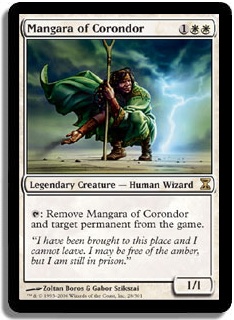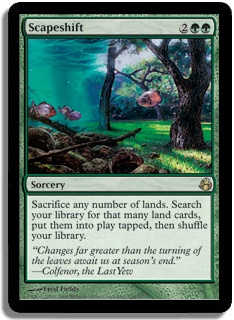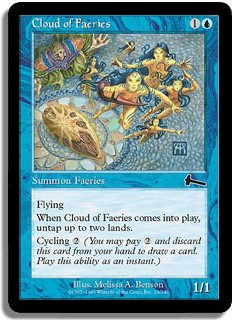When we talk about tournament Magic, we assume everyone is looking for the best deck, the deck that will give them the best chance to actually win a particular tournament. That being the case, we expect players to pick tried and true lists, ones that have proven their value and power, and tune it little—maybe switch a slot here and there depending on the expected metagame. Whenever that actually happens—usually because of hype—we get Top 8s with five Canadian Threshold (aka RUG Delver) lists, one U/W Stoneblade player, and two people running Maverick to represent the non-blue slice of the metagame. If you tell people often enough that there are only three viable deck types, a lot of them are bound to believe it and will bring variations on the same themes.
The results of tournaments that end up like that are predictable; they sustain forum debates about banning cards, complaints that the format is boring, and all the other problems that stem from Magic players hating solved formats. Yet Legacy, in my experience, hasn’t ever been a solved format yet (even during the Survival era), just one enough people believe to be solved to make it look that way for a tournament or two.
Luckily, it rarely ever remains that way thanks to some truly amazing people—the brewers and deckbuilders, the tinkerers and players who can see the promise and potential behind interactions and deck types others (dis)miss and decide to just push until they get them to work. These players, by ensuring they enforce the wide-open nature of a format as huge and still rather unexplored as Legacy, are the true heroes of the format.
By investing days upon days and an incredible amount of brainpower, these people make sure Legacy actually plays out as we all love it: wild, varied, and surprising. A format in which you can never be sure if your next opponent is going to try to kill you before you’ve made your first land drop or to grind you out in a game of thirty turns only to kill you with a Mishra’s Factory after having eliminated every mana source you had.
Today I’d like to talk about a few creations that feel like they’re ready for the big stage. Lesser-known decks that exist only because someone decided to pour their blood, sweat, and tears into exploring some interaction everyone else dismissed out of hand, investing hours of grinding, brainstorming, and tuning until the deck finally reached a point where it could hang with the big boys.
This is the true secret behind viable decks in Legacy: enough time, brainpower, and heart has been invested into honing them. The Legacy card pool is so huge and the overall power level so surprisingly low that there are thousands of interactions that actually have the potential to beat the crap out of most everything the pairing software could throw at them. The trick is finding all the necessary pieces and putting together the correct mix. Once that is done, it’s only a matter of exposure and enough players being intrigued by the concept to give the metagame yet another viable deck.
Always remember that decks like Maverick, Lands, and Dredge didn’t start off as obvious powerhouses. On the contrary, all of them were considered weird or underpowered pet decks at some point in time, until they actually reached a point where they worked. Now they are respected predators that limit which decks we consider playable themselves.
Now obviously there is a limit to what you can achieve just by working on a deck. If what you’re aiming for is simply not good enough, no amount of work will make it so. Then again, Sam Black Zombies brew carried him to a GP Top 8, and I had absolutely never expected to see those particular cards on the big stage.
But enough general philosophy; let’s take a look at some quirky lists, shall we?
Nothing In This World Is Certain
… Except death and taxes.
Creatures (26)
- 4 Mother of Runes
- 3 Mangara of Corondor
- 4 Serra Avenger
- 4 Flickerwisp
- 4 Stoneforge Mystic
- 3 Phyrexian Revoker
- 4 Thalia, Guardian of Thraben
Lands (12)
Spells (22)

A White Weenie deck based on abusing Flickerwisp, Mangara of Corondor, and Karakas—in Legacy? Really?
No, I’m not joking. This deck is actually quite impressive and is a prime example of one of those decks that looks weak but works because it has been so carefully crafted and revised over the years.
I mean, as far as I know, Finn has been trying to get this to work ever since Mangara appeared in Time Spiral, and it really is a work of art. The first time I played against the deck, I approached it with the typical "oh sweet, I’m paired against White Weenie" mentality—I was playing CAB Jace, after all, possibly the most creature-unfriendly deck ever devised. A quick game 1 loss cured me of that illusion (though the ridiculous removal suite pulled through in the end), and I’ve been impressed with the deck whenever I’ve actually seen it in action.
First and foremost, while Death and Taxes conforms to the traditional definition of White Weenie (a deck full of small white creatures), it doesn’t really play the way one would expect when hearing the term. The deck doesn’t actually try to beat you down. Instead, it plays a lot like a Prison Control deck in which the lock pieces just happen to kill the opponent even while locking them out of the game.
Some decks just fold to a 3/3 vigilance flyer with a Sword. Others succumb to the mana denial package of Rishadan Port, Wasteland, and Thalia. Yet others fight back for ages only to finally go down when Mangara has removed their tenth permanent from the game.
The heart of the matter is that, whatever you’re trying to do, Death and Taxes is going to mess with it in some way, shape, or form. And while you’re trying to get rid of all those pesky annoying things that keep you from really doing what you want to be doing, the clock is slowly but surely ticking down to zero, be it because you end up with too few permanents to still play the game or because some of those bodies attached to the disruption end up killing you.
As an aggressive deck, Death and Taxes is a failure. Its creatures are tiny, and its damage output overall is pitiful compared to what most other decks can do. If you want to stop it from beating you down, a reasonably sized Tarmogoyf is often all you need. The trouble is that, while you might not be taking any damage, you usually also aren’t able to do anything actually constructive. Your creatures can’t get through, your spells are really hard to cast, your Jace gets Revokered, and your removal is blanked by Mother of Runes. In the end, all you’ve worked for gets eaten up by the taxes, leaving you dead in the water. And that’s where the deck succeeds admirably.
Good Old Rock
I’m not sure if I should be angry at Eric Warns or celebrate with him. You see, here I was, planning this article about cool archetypes that haven’t had their time in the sun yet, and he goes and makes Top 8 of a SCG Legacy Open with one of them right while I’m writing the darned article. He couldn’t have waited another week, could he?
(Just kidding, Eric. Thanks for helping make Legacy fun, and congrats on the Top 8!)
Here’s the list I was planning to talk about, along with Eric (very similar) list so you can compare the two. They are both from Top 8s in the last month.
Creatures (14)
- 2 Wood Elves
- 2 Eternal Witness
- 4 Veteran Explorer
- 1 Wickerbough Elder
- 1 Primeval Titan
- 2 Huntmaster of the Fells
- 2 Thragtusk
Lands (16)
Spells (30)

Creatures (15)
Lands (16)
Spells (30)

Legacy’s one actual Rock deck—as in B/G/x midrange/control deck—Nic Fit has seen a solid amount of play already, at least here in Europe, and also managed to sneak into a SCG Legacy Open Top 8 or two back in the spring. Yet I always felt the deck was missing something. I believe the Scapeshift combo kill was that something.
The deck plays like you’d expect. You use your removal and Cabal Therapy to stop the opponent from getting ahead while abusing Veteran Explorer and the sacrifice effects to ramp up to your end game rapidly (Therapy is particularly sweet there as it usually means they can’t instantly profit from the lands you’ve handed them). Some beefy creatures (and Green Sun’s Zenith to get ramp off fatties) allow you to control the board when the removal just isn’t enough.
The problem this plan regularly runs into is the traditional problem for non-blue (therefore counter-less) control decks, made worse by the fact that Veteran Explorer accelerates both players: opponents topdecking better than you do to take the game before your creatures can finish the job. By adding the Burning Wish / Scapeshift package, the deck gains the ability to fully abuse the extra lands put into play by Veteran Explorer to actually end the game as soon as control is established while keeping access to enough removal to safely pass through the early game.
I’ve previously written about the value of hybridization, and I think a deck like Nic Fit is the perfect candidate for adding a highly synergistic combo kill that has extremely low slot requirements (other than forcing you to run a relatively high number of nonbasic lands).
Having a combo kill that just wins the game once you hit seven to eight lands (eighteen damage should be enough in a format with fetches, Force of Will, and your own creatures) is incredibly valuable in a deck that otherwise plans to go for the long grind but can’t actually stop anything they rip off the top of their deck. Also, the limited time you have in rounds is a real thing to consider.
Like Dust In The Wind
If you followed the Legacy MOCS a few weeks ago, you probably already saw this deck, though that tournament seems to have been overshadowed by real life events (a mistake considering its size). Andrew Cuneo is one of my favorite old school deck designers, and the deck he brought to the digital Legacy tournament is just incredibly sweet:
Creatures (10)
Lands (10)
Spells (40)

Andrew Cuneo was the mastermind behind the original Draw, Go deck and definitely seems to share my enthusiasm for drawing a million cards (I wonder if that has something to do with the fact that he’s at least as old school as I am).
While the Enchantress engine itself has seen a good amount of fringe use in Legacy, it has usually fueled a G/W Prison Control deck. What Cuneo did instead was to go back to the deck’s Extended incarnation, building a very resilient combo deck.
Instead of defending himself from attacks in the traditional way (setting up a crew of enchantments to make him impossible to kill), his deck relies on a few cheap utility enchantments to slow the opponent down while setting up one of his twelve ways to get an Enchantress effect into play early—brilliant use of Green Sun’s Zenith, by the way—to enable a card advantage engine that rapidly spirals out of control, leaving the opponent with no permanents on the board while he himself can recur Mindbreak Trap every turn.
What the deck plans to do is this: get out an Enchantress as soon as possible and start casting a lot of cheap enchantments to find another, hopefully placing a lot of Wild Growths and Utopia Sprawls on a pair of basic lands in the process. Once the engine starts rolling, you’ll draw into Cloud of Faeries to untap those two lands, generating mana to keep casting enchantments until you find a Words of Wind. Once Words is in play, you keep replacing some draws from casting your enchantments (with all the cards you draw, you’ll end up with quite a few Enchantress effects at this point) to return a couple of Cloud of Faeries to your hand and generate more mana. Optionally you also get to bounce a one-drop enchantment to keep going.
Once you reach that point, you keep doing this over and over until all opposing permanents are safely back in their hand and you’ve drawn into your Mindbreak Trap to make any comebacks impossible—you can, after all, recur the Trap indefinitely by bouncing Eternal Witness with Words. At that point it will only take a few turns until your makeshift army of 1/1 Faeries and 2/1 Shamans has put the opponent out of their misery while Green Sun’s Zenith makes sure you never deck (bounce some Enchantresses with Words if necessary).
So far I can’t really say how good this deck actually is—though Cuneo’s placement suggests it’s at least solid—as the one big thing I’ve learned in testing so far is that the deck is far too complicated to just pick up and play. I had to concede practically half the games I played after realizing that I screwed up badly but had already drawn too many cards to meaningfully rewind the game to see if I would have won or lost given correct play. What I can say is that the deck does have a lot of raw power and does some crazy things—and, oh yeah, the fun factor is through the roof.
Heroes Unite
The three decks I highlighted are actually not even the tip of the iceberg as far as powerful, outside the box Legacy decks are concerned that could do with a little more than just a cult following. You don’t even have to search hard; there just is an incredibly deep pool of decks waiting to break out in Legacy for anyone interested in looking, one of which should suit the idiosyncrasies of any kind of player.
Nothing more than a simple look through SCG Legacy Open Top 16s over the last few months will provide you with a ton of worthy options for something new and different that has proven it at least has the potential to get there (anyone remember Blouses?). Beyond that, there are literally dozens of decks out there just waiting in the jungle of the Internet (I would suggest checking mtgthesource.com) that simply don’t have enough players playing them to be seen at the upper tables.
Even if a particular shell or synergy isn’t good enough for the top tier just yet, there’s always a chance that the next set will contain that elusive missing piece to make a deck good or even insane (just remember what happened to Survival once Vengevine saw print and Caleb figured out how to build that deck—from minor player to format dominator in a few short months). Trust me, the effort spent pondering, brainstorming, and tuning is definitely worth it—Magic, even tournament Magic, is still a game, after all, and there are few things more fun than getting that weird pile of cards nobody else understands to work.
I hope you enjoyed this little introduction to some of the creations of Legacy’s true heroes. Let me know what you think in the comments or share your experiences with sweet, powerful, underplayed decks there—maybe I’ll even see something I want to take for a spin. Until next time: be a hero!



